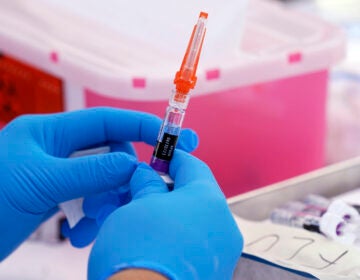How long before we know if reopenings cause virus spikes?
Experts say it could take several weeks to see enough testing data to know how lifting restrictions is affecting the spread of COVID-19.

In this Wednesday, May 13, 2020 file photo, Sheila Kelly, owner of Powell's Steamer Co. & Pub, center, stands behind makeshift barriers as she helps patrons at her restaurant in the El Dorado County town of Placerville, Calif. (AP Photo/Rich Pedroncelli)
U.S. states and countries worldwide are cautiously relaxing restrictions while watching for potential spikes in coronavirus infections. Getting the timing right is complicated. Disease trackers note the impossibility of seeing clearly what’s happening without widespread testing.
A look at when we might start to see any health impacts of reopening:
WHEN ARE WE GOING TO KNOW?
The virus can circulate undetected, then flare up in a nursing home or after a family gathering. So it could be several weeks to see surges in infections. What’s more, there are still new infections happening now during lockdowns. Some parts of the U.S. are seeing increasing numbers of daily new cases and some are seeing declines. Health officials will be looking at the number of new cases per day and the percentage of positive COVID-19 tests.
WHY DOES IT TAKE THAT LONG?
After exposure to the virus, it can take three to five days for someone to feel sick, and many infected people won’t have symptoms or only mild ones. Some with mild illness might delay getting tested. It can take another few days to get test results back and report them. All told, it can take two weeks or so — the time for one group of people to spread the virus to another — to have enough testing data. Crystal Watson of the Johns Hopkins Center for Health Security said it will take a few rounds of infection spread — five to six weeks — to know how reopening has affected epidemic curves.
IF THERE’S A SPIKE, HOW WOULD WE STOP IT?
Ideally, investigators would call people who test positive, track down their contacts and get them into quarantine before they can spread the virus to others. There’s evidence the coronavirus can spread before people feel sick, making it important to act quickly. States are just starting to expand their ability to do this contact tracing. Without adequate testing and contact tracing, returning to restrictions or a lockdown might be necessary if there is a surge in infections.
___
The Associated Press Health and Science Department receives support from the Howard Hughes Medical Institute’s Department of Science Education. The AP is solely responsible for all content.
WHYY is your source for fact-based, in-depth journalism and information. As a nonprofit organization, we rely on financial support from readers like you. Please give today.



![CoronavirusPandemic_1024x512[1]](https://whyy.org/wp-content/uploads/2020/03/CoronavirusPandemic_1024x5121-300x150.jpg)


